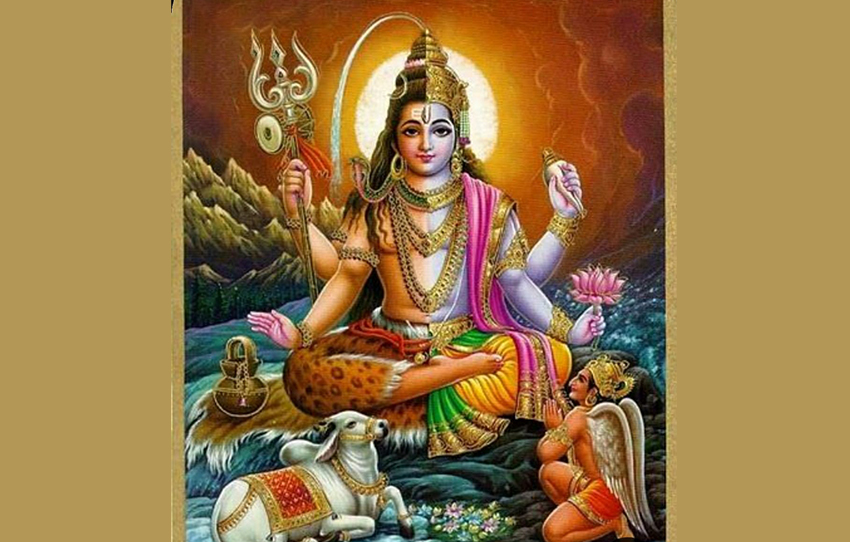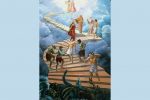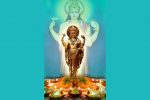NAME 27
Śivaḥ शिवः
He is benevolent, auspicious and gracious. MāṇḍūkyaUpaniṣad (7) says,
prapañcopaśamaṁśāntaṁśivamadvaitaṁcaturth
aṁmanyantesaātmāsavijñeyaḥ
प्रपञ्चोपशमंशान्तंशिवमद्वैतंचतुर्थं
मन्यन्तेसआत्मासविज्ञेयः
‘The embodiment of peace, the sum total of all that is good (śivam), one without a second, the fourth state of turya. Think this turya to be the Self, and this Self has to be realised.’ This nāma subtly conveys the essence of the Self. Viṣṇu is in the form that Self. His Brahmanic status is reaffirmed though this nāma.
Śiva also means purity. Only the Brahman is the absolute form of purity. Brahman remains pure as He is devoid of guṇa-s. Guṇa-s are the attributes of Prakṛti. What is the quality of the Brahman? The next nāma explains this. One who confers auspiciousness. subha avahascasivah – One who bestows auspiciousness on all.
२७. ॐ शिवाय नमः।
27. Om Shivaya Namah
Sivah -The One who is Eternally Pure. In Him can never be any contamination of the imperfection of Rajas and Tamas. ‘Non-apprehension of Reality’ is Tamas and ‘misapprehensions of Reality’ constitute the Rajas. In the Reality Itself there can be neither of them ‘He is Brahman; He is Siva’, so the Upanishad declares of the Absolute Oneness, which is Vishnu
Sivananda states: “Shiva and Vishnu are one and the same entity. They are essentially one and the same. They are the names given to the different aspects of the all-pervading Supreme Soul or the Absolute. ‘Sivasyahridayamvishnur-vishnoschahridayamsivah—Vishnu is the heart of Siva and likewise Siva is the heart of Vishnu’.
INTERPRETATION GUIDED BY SANT VANI (WORDS OF SAINTS)
Śivaḥ
The auspicious.
The Lord is called Śiva, auspiciousness. Being free from all the three guṇas, He is śuddha, pure.
The Kaivalyopaniṣad talks of Him as, ‘sabrahmā, saśivah’ (8) and the Narayaṇasūkta as ‘sa brahma saśivah.’ He is Brahmāji, He is Brahman, He is Śiva and also the others.
This is an important name to note, both for exclusive Viṣhṇu bhaktas and exclusive Shiva bhaktas. Here Lord Viṣhṇu is praised by a name such as Śiva. These names are also used for Lord Śiva in ŚivāSahasranāma, thereby, showing the abheda, non-difference between the two.
One may wonder, were the rishis confused? Certainly not.
It is important to understand the growth of a devotee, a person who is discovering his relationship with the Lord. Whether we acknowledge or not, we happen to be connected to the Lord, pervaded by the Lord in more ways than we can imagine.
Initially, a devotee prefers to relate to the Lord as a single form (ekā-rupa). This could be Ganāpati, Viṣhṇu, Śhiva or any ishtadevāta, liked deity that resonates with the devotee. The Lord is related to, as primarily this form. Fights emanate between different bhaktas, devotees because they think their Lord, the form they relate to is the best or the highest. In time, the devotee recognises and accommodates many other functions and forms of the Lord.
Levels of understanding of Shiva Linga
The lowest level at which we understand the Siva Linga is at the level of physical union. It is the male phallus which is called Siva and the female yoni which is called Parvati. It is their union that we are worshiping. There, the union is for procreation.
At the next highest level, the fire in the navel center and the love in the heart center, their union is called Siva and Shakti. In the next higher level still, space is considered the womb and time is the linga which is moving.
The universe of space and time is called the Siva Linga. All the five elements, all the ways in which we perceive, all these are considered to be lingas.
After these three levels, we reach the fourth and transcendent level where there is no distinction between the seer and the seen. They have become one. That is the highest form of the linga. It is called alinga. There is no linga there. There is no characteristic that differentiates one from the other. You are joined so totally with the world. You have absorbed the whole world into yourself and there is nothing other than you. So, to reach that state is called moksa.
A simplistic example to assimilate this is the use of our hands and legs. It is one body; neither the hands nor the legs are superior in any respect. Both are required for functioning. The devotee may still relate to his/her ishtadevāta. In addition, the devotee also relates and prays to other forms of the Lord (aneka-rupa). There is no conflict.
The devotee fulfills the purpose of his relationship with the Lord, in the discovery of the Lord as that formless reality (arupa) in all the deities and forms of the Lord. There is no form which is not the Lord.
Shiva and Vishnu are the one and same entity. They are essentially one and the same. The Supreme lord of Shiva is Vishnu and the Supreme lord of Vishnu is Shiva. Same Lord is moving in the world in two forms. Shiva is in a form of Vishnu and Vishnu is in the form of Shiva. There is no difference between them and both provide auspiciousness. Vishnu is in the heart of Shiva and Shiva is in the heart of Vishnu.
Shiva and Vishnu are manifestations of the same cosmic energy that creates, sustains and destroys the a Universe. So Lord Vishnu and Lord Shiva complete each other’s existence. Each one of them is vital for the Universe. Lord Hari is the preserver of the Universe while Lord Shiva is the destroyer and provides path for next creation.
One of the 1000 Names of Lord Narsimha is LalitA Among other names that clearly link Narayana and Devi as the same. If you read the pradhanikamrahasyam you will understand that Lord Maha Vishnu is the male aspect of Devi MahaParvati..The Mohini form of Vishnu was obtained from Lalita Maha-Tripurasundari. Let’s understand the unity of the devas.
In the Rama avatar, Lord Rama offered his prayer to Lord Shiva in the Rameshwaram before leaving to lanka for battle with demon king Ravana. Lord Shiva blessed Rama and he eventually overpowered and killed Ravana.
Lord Vishnu saved Lord Shiva from his own devotee Bhasmasur. Lord Shiva had blessed Bhasmasur with power that he could burn anything he places his hands. HoweverBhasmasur tried to test the power and wanted to place his hands on Lord Shiva. At that time Lord Vishnu came to save Lord Shiva. He took the form of a female Mohini and made Bhasmasur put his hand on his own head. So he was burst to ashes, and thus Lord Shiva was saved.
BhagwanParasurama who is an avatar of Lord Hari is the great devotee of Lord Shiva. In Krishna avatar, Lord Krishna worshipped lord Shiva to bring the tree KalpaVriksha from Indra.
Lord Hanuman who is the 11th avatar of Lord Shiva is the great devotee of Lord Rama who is an avatar of Lord Vishnu.
Raasaleela – It was the day when the Aaradhana of gopika was blessed by Lord Krishna. Lord Shiva, the greatest bhakta of shri Krishna also present in the form of gopika. Krishna realized that Shiva is none other than one of the gopikas having Sampooranaaanandham of dancing with him. Shri Krishna then does stuti of Eshwara and ask to bless them by staying there at Vrndhavana by the name of Gopeeshwara.



